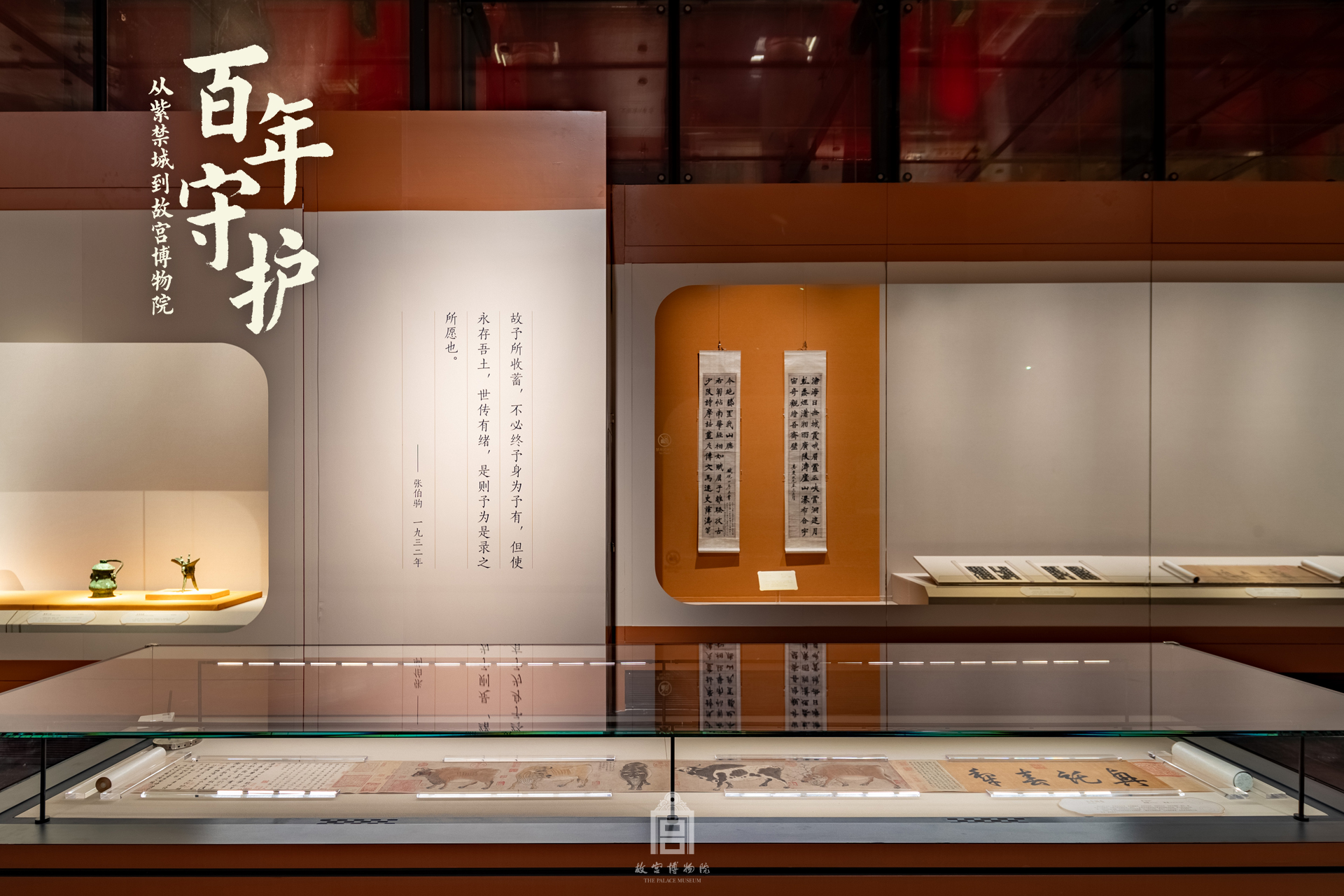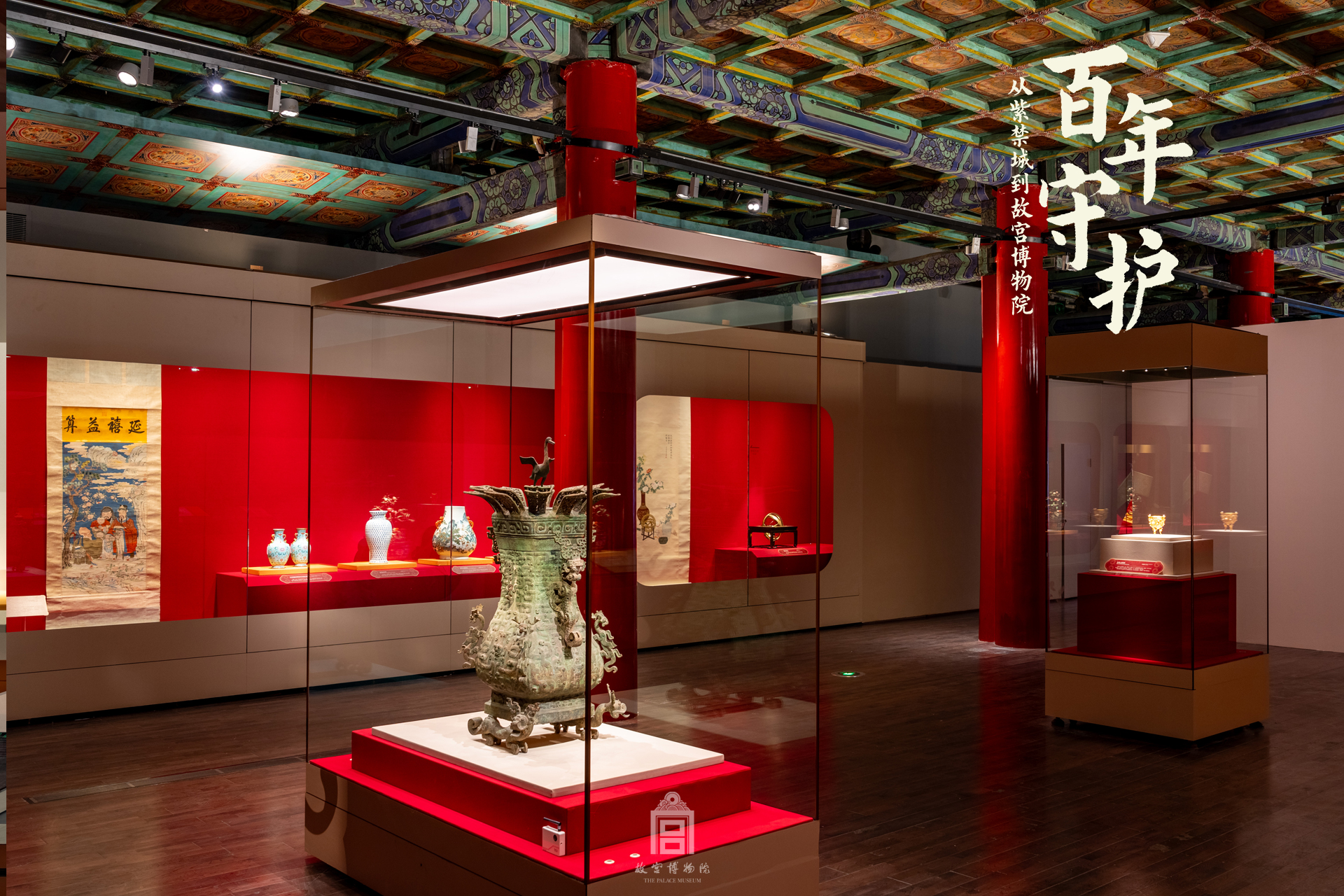Amid the Palace Museum’s 100th anniversary celebrations, an exhibition titled “A Century of Stewardship: From the Forbidden City to the Palace Museum” opened to the public in the Meridian Gate (Wu men) gallery of the Palace Museum on September 30.
Featuring 200 pieces and sets of cultural relics, the exhibition is divided into three sections: “A Lineage of Civilization,” “A Century of Endeavor,” and “Myriad Visions of Splendor.” Together, they showcase the defining characteristics of Chinese civilization—its continuity, innovation, unity, inclusiveness, and enduring spirit of peace. Through these works, visitors are invited to trace the Palace Museum’s journey over the past hundred years—from its founding and struggles in the early years, to its steady growth and ongoing pursuit of innovation in more recent decades.
The exhibition’s opening ceremony was held on September 29 in the Baoyun Building, also known as the Hall of Embodied Treasures. Distinguished guests attending the opening ceremony included Wang Xudong, a member of the Central Committee of the Communist Party of China (CPC) Leadership Group of the Ministry of Culture and Tourism and director of the Palace Museum; Rao Quan, vice minister of culture and tourism and head of the National Cultural Heritage Administration (NCHA); Zou Xiaodong, secretary of the Party Leadership Group and director of the Counselors’ Office of the State Council; Du Zhanyuan, president of China International Communications Group; Wang Ning, secretary of the Party Leadership Group and President of the National Centre for the Performing Arts; Zheng Xinmiao, former director of the Palace Museum; Shan Jixiang, former director of the Palace Museum; Liu Yuzhu, chairman of the China Foundation for Cultural Heritage Conservation; and Ji Zhihong, a member of the Party Committee and vice president of China Construction Bank (CCB). Also in attendance were representatives from relevant departments and institutions under the CPC Central Committee and the State Council, cultural heritage institutions under the Ministry of Culture and Tourism and the NCHA, relevant departments under the Beijing Municipal People’s Government, neighborhood and resident institutions, representatives from related associations, academic societies, and foundations, as well as retired senior experts and former leaders of the Palace Museum, and members of the museum’s leadership team. The event was presided over by Du Haijiang, Party secretary and deputy director of the Palace Museum.
The exhibition received strong support from the CCB, which serves as a joint promotion partner. In collaboration with the Palace Museum, the CCB has launched specially designed precious metal cultural and creative products, the “Auspicious Beasts in the Palace Museum” collection. The collection aims to promote the excellence of traditional Chinese culture and brings a contemporary interpretation through exquisite craftsmanship and modern design.
A Century of Stewardship, A Legacy Continued
A century of vicissitudes; a century of stewardship. The Palace Museum was founded on October 10, 1925, transforming the former imperial palace of the Ming and Qing dynasties into a public cultural institution. Born in a time of national turmoil, the museum overcame extreme difficulties arising from institutional changes and a sluggish economy. During the Chinese People’s War of Resistance Against Japanese Aggression, the Palace Museum successfully relocated its treasured artifacts to the south for safekeeping. After the founding of the People’s Republic of China in 1949, with the support of the CPC and government, the museum ushered in a new phase of development. Solid progress was made in the conservation and restoration of its historic architecture, its collections management system was improved, and its exhibition programs continued to grow. Since the launch of reform and opening-up in 1978, the Palace Museum has further improved infrastructure and developed a comprehensive system for the collection, preservation, study, display, and promotion of cultural heritage. In the new era, the Palace Museum launched the largest renovation and conservation project in its history, along with a seven-year effort to catalogue and assess its collection. These initiatives have improved the preservation of the Palace Museum and boosted rapid development across all areas of the museum’s work.
Since the 18th CPC National Congress, General Secretary Xi Jinping has attached great importance to the protection and inheritance of cultural heritage at the Palace Museum, issuing important instructions that have provided guiding principles for the museum’s development. Guided by Xi Jinping Thought on Socialism with Chinese Characteristics for a New Era, especially Xi Jinping Thought on Culture, the Palace Museum has acted in line with the requirements for cultural heritage work in the new era and fully advanced initiatives to build a safe, academic, digital and dynamic museum. It is dedicated to preserving the best of China’s traditional culture housed in the museum in a thorough and responsible manner, advancing the protection of the Palace Museum as a World Cultural Heritage site, and boosting high-quality development across all aspects of the museum’s operations. Its work in heritage conservation, academic research, public service, museum operations and international exchange has grown steadily, and the museum’s role as a key window into Chinese history and culture has become more prominent in the new era. As a dedicated participant in the Global Civilizations Initiative, the Palace Museum aims to be a world-class museum, a model for heritage conservation, a leader in the integration of culture and tourism, and a platform for civilizational exchange and mutual learning. The Palace Museum, with its deep history, continues to thrive with vitality in the present day.
To systematically reflect on its century-long journey from an imperial palace to a public museum, the Palace Museum has organized the special exhibition “A Century of Stewardship: From the Forbidden City to the Palace Museum” under the guidance of Xi Jinping Thought on Culture. With a focus on the museum’s history, the exhibition combines artifacts and archival materials to present the Palace as a bearer of China’s 5,000-year civilization, a repository of the best of China’s traditional culture, a witness to cultural exchanges, and a testament to the ingenuity of the Chinese people. It highlights the perseverance and craftsmanship of generations of Palace Museum staff, tracing how the museum’s destiny has been intertwined with that of the Chinese nation. Since the 18th CPC National Congress, the museum’s staff have remained true to their mission and pressed ahead with determination.
The three sections of the exhibition, namely, “A Lineage of Civilization,” “A Century of Endeavor,” and “Myriad Visions of Splendor,” feature 200 pieces and sets of cultural relics carefully selected from the museum’s collections.

The West Wing Gallery explores the theme of “A Lineage of Civilization,” comprising “Preserving the Imperial Collections,” “Opening the Forbidden City,” and “Becoming the Palace Museum.” It explores the continuity, preservation, and use of the imperial collections, underscoring the enduring nature of Chinese civilization. The section also revisits key moments in the museum’s early history, including its founding, the adoption of the comprehensive conservation plan, the wartime relocation of cultural relics to the south, and the surveying and mapping of the Beijing Central Axis, showcasing the Palace Museum’s early, often arduous heritage preservation and research efforts.
The Meridian Gate Gallery hosts “A Century of Endeavor,” divided into “Reuniting National Treasures,” “Revitalizing Ancient Masterpieces,” and “Regaining Palace Splendor.” Through the lens of artifact acquisitions, allocations, and donations, this chapter tells the story of how the Palace Museum’s collection was built. The section illustrates the historical, artistic, and scientific value of the collections. Through displays on the techniques of painting and calligraphy reproduction and artifact restoration, the exhibition showcases the inheritance of conservation skills. It also presents major architectural conservation projects and innovative renovation practices, including that of the Palace of Tranquil Longevity (Ningshou gong), the Hall of Mental Cultivation (Yangxin dian), and the Hall of Supreme Harmony (Taihe dian), as well as the UNESCO World Heritage nomination for the Palace Museum and the Beijing Central Axis.
The East Wing Gallery houses “Myriad Visions of Splendor.” Its three parts: “Continuing the Lineage of Civilization,” “Celebrating a Symphony of Civilizations,” and “Embracing the Supreme Harmony,” presents the enduring significance of China’s 5,000-year civilization, illustrating how the Palace Museum contributes to the fostering of a strong sense of community for Chinese nation, participates in the Global Civilizations Initiative, and promotes dialogue across cultures toward building a community with a shared future for humanity.
The three chapters of the exhibition paints a vivid portrait of the Palace Museum’s 100-year journey of perseverance, innovation, and renewal. It embodies the collective efforts of generations of museum staff and the support of society at large. We hope this exhibition will provide visitors with cultural enrichment and fresh insights. It aims to deepen understanding of the Palace Museum, while fostering a stronger appreciation of Chinese cultural heritage. In doing so, it seeks to highlight the wisdom carried by artifacts as a bridge connecting the past and the future, and as a source of shared understanding today.

Visitor Information
The exhibition runs from September 30 to December 30, 2025. Admission is included with a regular museum ticket and requires advance online reservation via the Palace Museum’s official ticketing website.
Please follow the guidance of our staff on-site to ensure an orderly and pleasant visit for everyone. For high-definition digital images of our artifacts, you can explore the “Digital Relics” and “Famous Paintings in the Palace Museum” sections in the Palace Museum’s WeChat mini-program.


